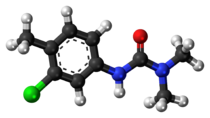Chlortoluron
Appearance

| |

| |
| Names | |
|---|---|
| Preferred IUPAC name
N'-(3-Chloro-4-methylphenyl)-N,N-dimethylurea | |
| Other names
3-(3-Chloro-4-methylphenyl)-1,1-dimethylurea
| |
| Identifiers | |
3D model (JSmol)
|
|
| ChEBI | |
| ChemSpider | |
| ECHA InfoCard | 100.035.978 |
PubChem CID
|
|
| UNII | |
CompTox Dashboard (EPA)
|
|
| |
| |
| Properties | |
| C10H13ClN2O | |
| Molar mass | 212.67602 |
Except where otherwise noted, data are given for materials in their standard state (at 25 °C [77 °F], 100 kPa).
| |
Chlortoluron is a phenylurea herbicide used to control broadleaf and annual grass weeds in cereal fields. [1][2]
Referenced
- ^ Lhomme, Ludovic; Brosillon, Stephan; Wolbert, Dominique; Dussaud, Joseph (2005). "Photocatalytic degradation of a phenylurea, chlortoluron, in water using an industrial titanium dioxide coated media". Applied Catalysis B: Environmental. 61 (3–4): 227–235. doi:10.1016/j.apcatb.2005.06.002.
- ^ Smith, A.E.; Briggs, G.G. (1978). "The fate of the herbicide chlortoluron and its possible degradation products in soils". Weed Research. 18 (1): 1–7. doi:10.1111/j.1365-3180.1978.tb01568.x.
